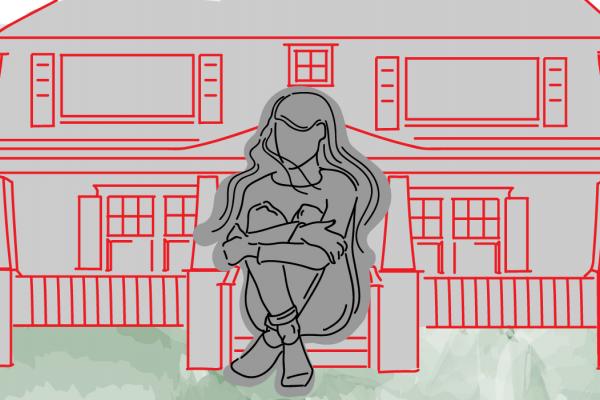During Frank Tenuta’s 33-year tenure as an attorney, he’s heard various versions of how it begins.
“I was in the shower and all of a sudden I heard my landlord out there saying, ‘Hey, anybody here? I knocked and nobody answered so I just came in.’”
Tenuta’s first case of sexual harassment in housing occurred in the mid-to-late 1980s. The woman was behind on her rent. The landlord said he would look the other way if she performed sexual favors.
“Quid pro quo,” Tenuta said, referencing the legal classification of the proposed exchange. “I won’t evict you.”
Tenuta can’t say for certain how many cases like this he’s taken on while at Iowa Legal Aid. He said the organization doesn’t have a case category to track the number of complaints related to sexual harassment in housing that come through its doors.
“It’s probably just a historical thing,” he explained.
Iowa Legal Aid isn’t alone in its reporting methods. Under the Fair Housing Act, sexual harassment in housing complaints fall under “discrimination in housing based upon sex” — which could mean anything from a landlord refusing to rent units to women, to a maintenance worker asking a resident to perform sexual favors.
It’s created a problem of “both underinclusion and overinclusion,” said Kate Sablosky Elengold, a professor of law at the University of North Carolina who served as a trial attorney in the Civil Rights Division of the U.S. Department of Justice. “Overinclusion in the numbers because sexual harassment is a subset of sex discrimination [and] … underinclusion [due to] the fact that people don’t report these issues.”
It’s that murkiness in the numbers, combined with a lack of training and awareness, that has made sexual harassment in housing such a widespread, yet under the radar, problem. But local housing authorities are working to combat the problem on the ground. Their efforts could serve as a model for other communities.
‘Bad Actors’
In 2017, the National Fair Housing Alliance reported 1,917 complaints in which “sex” was listed as a possible factor.
One or two of those complaints may have originated in Sioux City, Iowa, a city of nearly 83,000 that straddles the South Dakota and Nebraska border. It’s a place residents consider to be fairly affordable. Most people own their own homes. Those who rent aren’t renting out of choice, but out of necessity, said Karen Mackey, executive director of the Sioux City Human Rights Commission.
Most landlords are decent people just trying to make a living, she said. But necessity is what draws the “bad actors” out. They rent low-cost apartments and target people who are one paycheck from homelessness — people who will do anything to keep from having to move.
“If you’re one of those few landlords who is a predator, that’s very appealing,” Mackey said. “You’re a wolf in a field of sheep.”
Over the past 10 years, Mackey said, the most sexual harassment in housing cases she’s seen in a single year was four — but she knows that number represents just the “tip of the iceberg.”
“People who choose to harass others don’t just wake up one day and decide, ‘I’m going to sexually harass this individual,’” she said. “It’s a pattern of behavior that they have engaged in likely for some time, and that they will continue to engage in.”
Mackey is describing people like Doug Waterbury.
Waterbury owns 50 properties in Oswego County, N.Y, including the Sterling Renaissance Festival, Sylvan Beach Amusement Park, and Santa’s Workshop. He has been accused of sexually harassing female tenants since the 1990s — making lewd comments, physical advances, and sex-for-rent offers.
A post to an Oswego community Facebook group ultimately unraveled years of cover-ups. In the post, a woman alleged that Waterbury sexually harassed her niece. The post took off, with women commenting that similar things had happened to them or to someone they knew, even tagging the names of other women.
One of the comments on the post was made by a caseworker who had just completed a training with CNY Fair Housing, a non-profit in Syracuse, N.Y., that works to ensure equal access to housing in central and northern New York. She told the women they should contact the organization. Within four months, a case had been put together on behalf of six women.
Sally Santangelo, executive director of CNY Fair Housing, said it was a “snowballing effect,” as even more women came forward when the case became public. In April 2018, the U.S. Department of Justice announced that they had also filed a case against Waterbury. As of this reporting, the case had not been settled.
According to a report by Oswego County News Now, in the years prior, some of the women had gone to the police about Waterbury. Three investigations were conducted. But due to the higher standard of proof required for criminal cases, police concluded that Waterbury’s actions did not constitute any crimes per New York State Penal Law.
It is not unusual for women experiencing sexual harassment in their home to turn to the police for help, not realizing that a criminal proceeding requires evidence many women experiencing harassment aren’t able to provide.
Shameka Banks went to police in 2008 when a maintenance worker fondled her breasts and assaulted her while fixing her sink in Bossier City, La. After the worker assaulted Banks a second time when he entered her home to change a lightbulb, she told him that she would report him. He laughed. “Nothing will happen if you report me,” he said according to reports.
The police put a restraining order out on the worker, which he later violated, resulting in his termination. But the housing authority rejected Banks request to have her locks changed, despite the possibility that the worker still possessed a key to her unit. In May 2009, after months of barricading herself and her three children in the apartment, Banks succeeded in filing a fair housing complaint with the U.S Department of Housing and Urban Development (HUD) which was then referred to the Louisiana Department of Justice. In April 2011, the Greater New Orleans Fair Housing Action Center (GNOFHAC) — a private fair housing center six hours from her home — filed suit against the City of Bossier City Housing Authority.
While many women involved in harassment cases choose to remain anonymous throughout the process, Banks participated in news conferences and answered questions for the media.
“I think it made it clear to other people in other places that they could come forward,” said Kate Scott who was serving as the assistant director of the fair housing center at the time. “People read about the coverage or [saw] it on the news and understood that there’s a resource out there for them to go to if they’re experiencing harassment.”
But as Banks and the women who have filed suit against Waterbury have discovered, the resources available to those experiencing sexual harassment in housing are often neither timely nor able to address the complexities of their situation.
A Breach of Security
Some of the inefficiencies stem from the legal history of sexual harassment in housing.
While discrimination on the basis of sex has been included as part of the Fair Housing Act since 1974, the first reported decision on sexual harassment in housing wasn’t until 1985. The case, Shellhammer v. Lewallen, involved a married couple from Ohio, Thomas Shellhammer and Tammy Shellhammer, who were evicted from their apartment allegedly after Tammy rejected their landlord’s sexual advances. Due to a lack of legal precedent, the plaintiffs referred to Title VII, the equal employment statute that prohibits workplace harassment on the basis of sex. For years, subsequent courts followed suit, looking to employment cases to determine the severity of the claim.
But sexual harassment in housing plays out very differently than sexual harassment in the workplace.
“Harassment in housing is in some ways more insidious than harassment in employment because harassment in housing is in your own home, so you’re feeling a breach of security and severely undermined,” said Sandra Park, a senior attorney with the ACLU Women’s Rights Project. “At least if you’re experiencing workplace harassment that’s a place where you can leave at the end of the day.”
Park said that when she started at the ACLU, there were no fair housing regulations that spoke specifically to sexual harassment in housing. It wasn’t until September 2016 that she and other advocates ultimately succeeded in pressuring HUD to issue amended regulations to the Fair Housing Act that addressed the lack of standards and included examples for future proceedings.
While the amendments are a major step in the right direction, Park stressed that the amendments alone aren’t the solution.
“I think the main thing for me … [is that] every housing provider needs to adopt and implement a policy that prohibits sexual harassment and violence,” she said. “Compared to employment, this is just not the case … very few have any sort of policy that talks about sexual harassment and violence, so even if their staff does receive a report they’re not going to know what to do with it.”
Like others, Park stressed the need for training. Specifically, she recommended that housing providers partner with local groups to provide staff members with training about the issue.
“There’s just so many misunderstandings surrounding what sexual harassment looks like, and I think education and training is key to that,” she said.
Training More Than Tenants
CNY Fair Housing provides 40 to 50 trainings a year for caseworkers and housing providers. In every single training, they’ve discussed the Doug Waterbury case.
“We have trained caseworkers on how to recognize sexual harassment and make sure they understand that sexual harassment is an issue and that they can report those cases to us even if it’s merely a whisper, or if they hear rumors, or it’s even just one person’s story,” Santangelo said. “Because there more than likely will be others.”
In Sioux City, the Sioux City Human Rights Commission is just four floors above the department that handles housing vouchers, which Mackey said has allowed for a great working relationship between the two departments. Tenants receiving vouchers attend required meetings with the department staff, during which they are given information about fair housing and contact information for the Human Rights Commission. Mackey said she’s had many people arrive at her office that way.
“We frequently get people [saying], ‘I just talked to my Section 8 worker, they sent me up here,” Mackey said.
But the training they offer isn’t just for tenants.
Each April, Mackey’s team partners with Iowa Legal Aid to lead an educational workshop for landlords and property managers.
“The managing attorney from Legal Aid always does the presentation and he has this one saying … ‘It’s the tenant’s home, but it’s the landlord’s house,’” Mackey said. “So that you know each party has something there.”
Training for housing providers seems pretty standard, but Cashauna Hill, executive director of the Greater New Orleans Fair Housing Action Center, said that renting housing on the private market is a “business enterprise that requires virtually no training to participate in and profit from.”
“I’m often shocked by the number of landlords I encounter who freely admit that they’ve never had any training,” she said. “Not only on the applicable landlord/tenant laws, but also on the fair housing laws. And these are folks who make their living renting homes that we raise our families in.”
It’s why Hill says Fair Housing training is frequently included as part of injunctive relief in a settlement. In Sioux City, Mackey said landlords have even been asked to distribute fair housing brochures to their tenants, hang posters explaining sexual harassment in housing rules, or pay for a billboard advertising fair housing services.
The Problem With Numbers
While increasing awareness of resources and training efforts have been instrumental to combating sexual harassment in housing, there are still limitations. One inhibitor — a lack of data.
“Housing authorities should be reporting and recording data on harassment complaints they receive and how they are resolved,” Park advised.
As far as she knows, no such mechanism exists despite efforts made.
“Lack of information leads to a number of problems,” wrote Rigel C. Oliveri, a law professor at the University of Missouri. “Policymakers and legislators have difficulty addressing sexual harassment in housing because they do not know basic facts about it, such as how common it is, who is likely to experience or perpetrate it, and what form(s) it takes.”
According to Oliveri, there have been just four empirical articles published on sexual harassment in housing. Out of those four, only two used data to look at prevalence. Both are more than 20 years old.
In a recent study she conducted, Oliveri individually interviewed 100 women living in Columbia, Missouri. Ten of them reported experiencing sexual harassment serious enough to meet the legal standard. All of the women were low-income and six of them were not receiving Section 8 Vouchers or rental assistance. None of them were aware of HUD or civil rights agency resources.
Oliveri’s research highlights a gap in sexual harassment efforts. Even if Section 8 Voucher tenants and landlords are provided training on fair housing law, women without vouchers are left out of the knowledge loop. And as Oliveri’s research shows, they are often the most vulnerable to the harassment.
Out from Behind Closed Doors
In April 2018, 50 years after the passage of the Fair Housing Act, the DOJ announced a nationwide rollout of a sexual harassment in housing initiative that had been introduced as a pilot program in October 2017. In partnership with HUD, the DOJ promised a “three-pronged approach” to address the issue which included: data sharing and analysis, training, public outreach, enforcement resources, public awareness campaigns, and a review of federal policies. Six months later, the DOJ shared that in the year since its launch, they had opened 34 new sexual harassment matters, nearly five times the number opened in the prior year.
cc-woman-01.jpg

Sara Pratt, who has worked in fair housing for 42 years and oversaw HUD’s enforcement of the Fair Housing Act, said that it’s important to publicize cases so people get a better sense of their rights and what the government is doing to seek remedies. But she stressed that more is needed to fully address the issue.
“There is not an organized support system for victims of sexual harassment in housing,” Pratt said. “There are people who can help them understand that they have rights and help them file a complaint, but it’s not quite the way it is done in domestic violence cases where the public recognition is reflected in specific funding and availability of housing for victims.”
Unlike domestic violence, sexual harassment in housing is just now beginning to gain public attention. Some of this attention can be traced back to the #MeToo movement, which brought to light the prevalence of sexual harassment in the workplace and lack of systemic remedy. But while the public has seen powerful men in the workplace fall from grace on the front page of newspapers, harassment in housing has continued to thrive behind closed doors.
“We do not yet know whether the scope of the problem of sexual harassment in housing is great enough to require the kind of A to Z remedies that people have become aware is needed in domestic violence settings,” Pratt said.
Changing the Narrative
In July 2018, DOJ officials hosted community leaders at the Sioux City Public Museum to discuss the sexual harassment in housing initiative and provide information and resources on how to identify and report sexual harassment in housing.
One of the attendees was Tenuta.
“Have I seen any big changes on a day to day basis?” he said in reference to the event. “No, but that’s not the way these kind of thing work.”
When he first started practicing, he said he used to have run-ins with police because they weren’t enforcing domestic violence laws. At the time, it was just Iowa Legal Aid and the Council on Sexual Assault and Domestic Violence working to combat the issue. But over time, awareness grew and attitudes changed. He said they now have regular coalition meetings with law enforcement, government officials, and social service workers.
“You know it’s funny, I was just listening to NPR the other day, and there was an interview with Ashley Judd,” Tenuta said. “Part of what she was talking about was just the attitude …. you know if a landlord goes in and says to a woman, ‘you didn’t pay your rent, you can have sex with me and I’ll forgive your rent,’ … most people would agree that’s wrong.”
But he noted that “on the other end of the spectrum you know a landlord making inappropriate comments about her body, that’s something that’s … ‘not a big deal.’”
More needs to be done, he said, but for now he’s grateful for the attention the issue is getting.
“You have to sort of push what’s acceptable to the point where even those kind of inappropriate comments become unacceptable,” Tenuta stressed. “Because when the inappropriate thing is acceptable it gives everybody more license to do the next step.”
Editor's Note: This article was produced in partnership with the Solutions Journalism Network.
Got something to say about what you're reading? We value your feedback!






